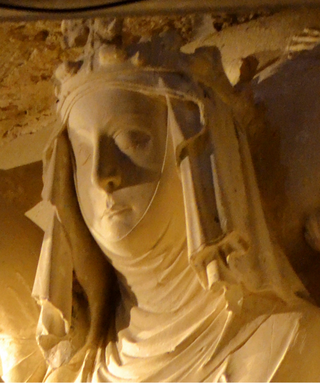
Alfonso IV, called the Kind was King of Aragon and Count of Barcelona from 1327 to his death. His reign saw the incorporation of the County of Urgell, Duchy of Athens, and Duchy of Neopatria into the Crown of Aragon.

Ferdinand IV of Castile called the Summoned, was King of Castile and León from 1295 until his death.

Henry II, called Henry of Trastámara or the Fratricidal, was the first King of Castile and León from the House of Trastámara. He became king in 1369 by defeating his half-brother Peter the Cruel, after numerous rebellions and battles. As king he was involved in the Fernandine Wars and the Hundred Years' War.

Sancho IV of Castile called the Brave, was the king of Castile, León and Galicia from 1284 to his death. Following his brother Ferdinand's death, he gained the support of nobles who declared him king instead of Ferdinand's son Alfonso. Faced with revolts throughout his reign, before he died he made his wife regent for his son, who became Ferdinand IV.

Peter I, known as the Just or the Cruel, was King of Portugal from 1357 until his death.

James II, called the Just, was the King of Aragon and Valencia and Count of Barcelona from 1291 to 1327. He was also the King of Sicily from 1285 to 1295 and the King of Majorca from 1291 to 1298. From 1297 he was nominally the King of Sardinia and Corsica, but he only acquired the island of Sardinia by conquest in 1324. His full title for the last three decades of his reign was "James, by the grace of God, king of Aragon, Valencia, Sardinia and Corsica, and count of Barcelona".

Henry IV of Castile, nicknamed the Impotent, was King of Castile and León and the last of the weak late-medieval kings of Castile and León. During Henry's reign, the nobles became more powerful and the nation became less centralised.

Don Juan Manuel was a Spanish medieval writer, nephew of Alfonso X of Castile, son of Manuel of Castile and Beatrice of Savoy. He inherited from his father the great Lordship of Villena, receiving the titles of Lord, Duke and lastly Prince of Villena. He married three times, choosing his wives for political and economic convenience, and worked to match his children with partners associated with royalty. Juan Manuel became one of the richest and most powerful men of his time, coining his own currency as the kings did. During his life, he was criticised for choosing literature as his vocation, an activity thought inferior for a nobleman of such prestige.

Constanza Manuel of Villena, was a Castilian noblewoman who by her two marriages was Queen consort of Castile and León and Infanta of Portugal.

Manuel of Castile (1234 – 25 December 1283, The first Lord of Villena and Peñafiel, Cuéllar, and Escalona, was an Infante, son of Ferdinand III of Castile and his wife Elisabeth of Hohenstaufen.

Constance of Portugal, was Queen of Castile by her marriage to Ferdinand IV.

María Alfonso Téllez de Meneses, known as María de Molina, was queen consort of Castile and León from 1284 to 1295 by marriage to Sancho IV of Castile, and served as regent for her minor son Ferdinand IV and later her grandson Alfonso XI of Castile (1312-1321).

Blanche of Anjou was Queen of Aragon as the second spouse of King James II of Aragon. She was a member of the Capetian House of Anjou, she is also known as Blanche of Naples. She served as Regent or "Queen-Lieutenant" of Aragon during the absence of her spouse in 1310.

Violant or Violante of Aragon, also known as Yolanda of Aragon, was Queen consort of Castile and León from 1252 to 1284 as the wife of King Alfonso X of Castile.
Constance of Aragon (1239–1269) was a daughter of James I of Aragon and his second wife Yolanda of Hungary. She was a member of the House of Barcelona and was Infanta of Castile by her marriage to Manuel of Castile.
Blanche of Castile was by birth a member of the Castilian House of Burgundy. She was the only child of Infante Peter of Castile and Infanta Maria of Aragon.

Juan III Núñez de Lara y de la Cerda, Lord of Lara and Vizcaya, son of Ferdinand de la Cerda (1275–1322) and Juana Núñez de Lara the Little Dove. Despite belonging to the House de la Cerda and aspiring to the Castilian-Leonese throne during the reigns of Sancho IV of Castile, Ferdinand IV of Castile and Alfonso XI of Castile, he carried the family name of his mother which corresponded to the name of his lordship.

Fernando Díaz de Haro was a Spanish noble of the House of Haro. He was the second born son of Diego López V de Haro, the Lord of Biscay, and his wife, the infanta Violante de Castilla y Aragón, daughter of Alfonso X of Castile. Fernando became lord of Orduña and Balmaseda in 1322, after the death of his brother, Lope Díaz IV de Haro who died without leaving any descendants.
Violant of Castile was infanta of Castile and Lady of Biscay on her marriage to Diego López V de Haro. She was the daughter of Alfonso X of Castile, and Violant of Aragon.
Maria of Portugal was a Portuguese royal, daughter of Infante Afonso of Portugal and his wife Violante Manuel.















